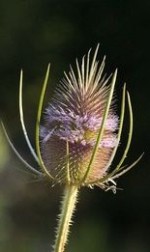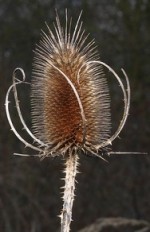
Brought to North America from Europe in the early 1700’s to raise the nap of wool cloth, fuller’s teasel naturalized and is now considered a weed in many parts of the United States. It is a biennial and a member of the honey suckle family, Caprifoliaceae, that also includes weigela, scabiosa, and abelia. In the first year the plant grows a tap root and forms a rosette of large coarse lanceolate leaves up to 12″ long. In the second year several spiny stems up to 6’ tall arise bearing sessile spiny leaves and clusters of spiny flowerheads from summer into fall. Each egg-shaped flowerhead is up to 4″ long and consists of numerous small pink, purple or lavender flowers, subtended by long pointed bracts. The flowerheads produce an abundance of 1 seeded fruits, called achenes, that have a high germination rate so plants readily reproduce themselves. Butterflies and bees love the flowers, birds, especially goldfinches, love the seed, and the dried seed heads look fabulous in dried arrangements. Plants can be found growing wild in sunny disturbed sites such as roadsides, riverbanks, and forest openings, and in savannas, grasslands and meadows and it is suitable for a wildflower, meadow, and prairie garden if seed dispersal is controlled. The genus name, Dipsacus, comes from the Greek word dipsa meaning thirst of water and refers to the cup-like formation made where sessile leaves merge at the stem. The specific epithet, fullonum, comes from the Latin word fullo meaning fuller and refers to the use of the seed heads in the manufacture of wool cloth by fullers.

Type: Biennial
Bloom: Egg-shaped flowerhead up to 4″ long and consisting of numerous small pink, purple or lavender flowers, subtended by long pointed bracts; from summer into fall.
Size: 4-6′ H x 1-2.5′ H
Light: Full sun to part shade
Soil: Moderately fertile, medium moist, well-drained
Hardiness: Zones 3-8
Care: Low maintenance; restrict seed dispersal to avoid invasive tendencies of plant.
Pests and Diseases: None of significance
Propagation: Seed
Companion Plants: New England aster, blanket flower, coneflower
Photo Credit: Wikipedia